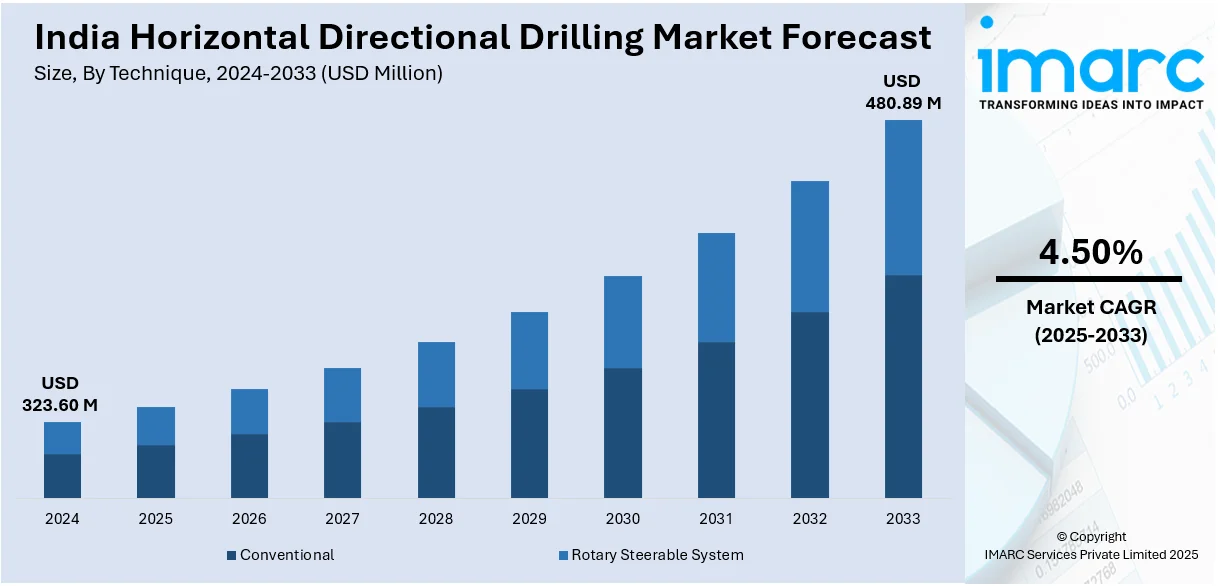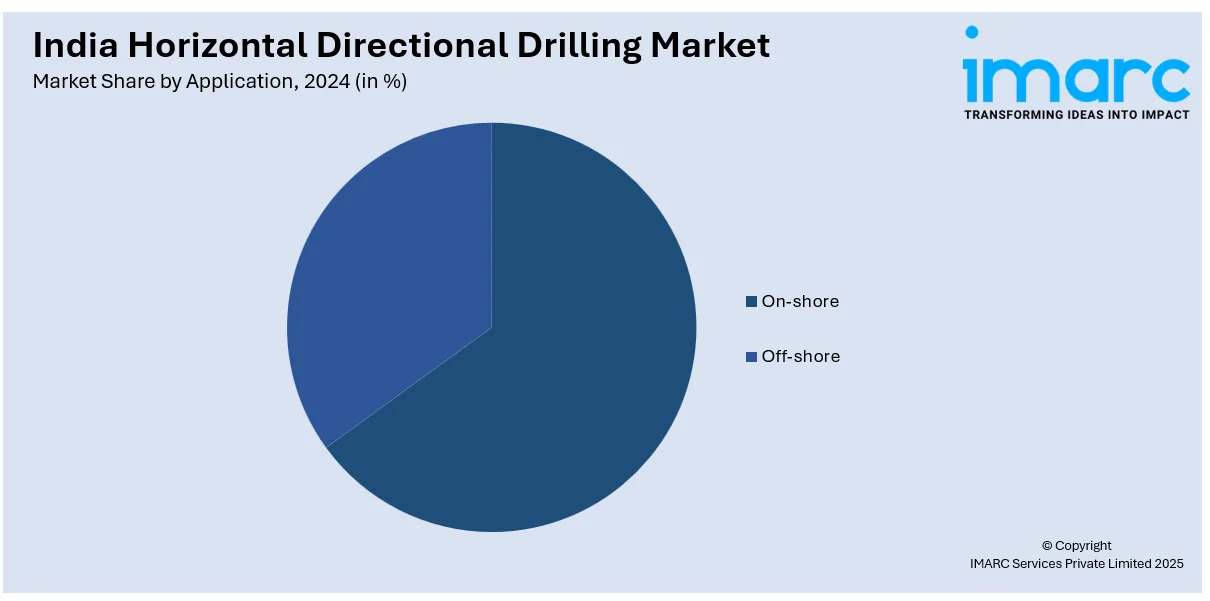
India Horizontal Directional Drilling Market Size, Share, Trends and Forecast by Technique, Parts, Application, End User, and Region, 2025-2033
India Horizontal Directional Drilling Market Overview:
The India horizontal directional drilling market size reached USD 323.60 Million in 2024. Looking forward, IMARC Group expects the market to reach USD 480.89 Million by 2033, exhibiting a growth rate (CAGR) of 4.50% during 2025-2033. The India horizontal directional drilling market is expanding because of increasing infrastructure projects, fiber optic installations, and oil and gas pipeline construction. Moreover, improvements in drilling technology, rising usage of trenchless solutions, and smart city and utility government programs are fueling market demand.
|
Report Attribute
|
Key Statistics
|
|---|---|
|
Base Year
|
2024 |
|
Forecast Years
|
2025-2033
|
|
Historical Years
|
2019-2024
|
| Market Size in 2024 | USD 323.60 Million |
| Market Forecast in 2033 | USD 480.89 Million |
| Market Growth Rate 2025-2033 | 4.50% |
India Horizontal Directional Drilling Market Trends:
Rising Demand for Underground Infrastructure
India's horizontal directional drilling sector is experiencing significant growth with the rising demand for underground infrastructure. Industrialization and urbanization are compelling the demand for cost-effective and less invasive methods for installing pipelines, cables, and fiber optics. Moreover, underground installation is enabled through HDD technology without interfering with surface operations, making it suitable for dense cities and ecologically sensitive areas. Telecom and energy sectors' infrastructure development projects are majorly contributing to market growth. Along with this, the installation of 5G networks involves large-scale deployment of fiber optic cables, for which HDD is of primary importance. Gas pipeline development projects conducted by public and private players are also raising the demand for HDD. Government policies encouraging smart cities and efficient water supply systems are also contributing to its usage. Also, emphasis on green construction practices is compelling firms to use HDD instead of traditional trenching. With increasingly stringent environmental regulations, the demand for trenchless technology is gaining traction. HDD prevents road closures, reduces land disturbances, and shortens overall project duration. Growing investment in utility infrastructure, along with improved drilling equipment and methods, are anticipated to consolidate the market's growth path in coming years.

To get more information on this market, Request Sample
Technological Advancements Boosting Efficiency
Drilling technology innovation is improving the accuracy and efficiency of horizontal directional drilling in India. Drill equipment manufacturers are launching automated drilling rigs, high-performance drill bits, and advanced tracking systems to enhance accuracy and speed. These innovations are making HDD more dependable for large-scale infrastructure projects. One of the key trends is the use of real-time monitoring and GPS-based guidance systems, which enable operators to navigate complex underground geologies with higher accuracy. This is especially beneficial in the installation of utilities beneath rivers, highways, and highly populated cities. Better drilling fluids and mud recycling equipment are also on the rise, lessening environmental impact and operating costs. Metro rail construction, sewer rehabilitation, and oil and gas pipeline infrastructure projects are boosting demand for high-efficiency HDD machinery. Most Indian contractors are embracing sophisticated HDD rigs to respond to the increased demand for more efficient and cost-saving underground installation. With increasing investments in R&D, the industry is observing the implementation of hybrid drilling technology that improves efficiency and minimizes equipment wear and tear. The demand for sustainable infrastructure growth and the increasing use of automation in drilling activities are anticipated to bring considerable opportunities for market expansion.
India Horizontal Directional Drilling Market Segmentation:
IMARC Group provides an analysis of the key trends in each segment of the market, along with forecasts at the region/country level for 2025-2033. Our report has categorized the market based on technique, parts, application, and end user.
Technique Insights:
- Conventional
- Rotary Steerable System
The report has provided a detailed breakup and analysis of the market based on the technique. This includes conventional and rotary steerable system.
Parts Insights:
- Rigs
- Pipes
- Bits
- Reamers
The report has provided a detailed breakup and analysis of the market based on the parts. This includes rigs, pipes, bits, and reamers.
Application Insights:

- On-shore
- Off-shore
A detailed breakup and analysis of the market based on the application have also been provided in the report. This includes on-shore and off-shore.
End User Insights:
- Oil and Gas Excavation
- Utility
- Telecommunication
A detailed breakup and analysis of the market based on the end user have also been provided in the report. This includes oil and gas excavation, utility, and telecommunication.
Regional Insights:
- North India
- South India
- East India
- West India
The report has also provided a comprehensive analysis of all the major regional markets, which include North India, South India, East India, and West India.
Competitive Landscape:
The market research report has also provided a comprehensive analysis of the competitive landscape. Competitive analysis such as market structure, key player positioning, top winning strategies, competitive dashboard, and company evaluation quadrant has been covered in the report. Also, detailed profiles of all major companies have been provided.
India Horizontal Directional Drilling Market News:
- January 2025: Engineers India Ltd (EIL) achieved the world’s longest Horizontal Directional Drilling (HDD) crossing at the PNCPL Project, successfully installing a 26-inch diameter pipeline under the Subansiri River using the Intersection Technique. This milestone enhances HDD adoption in pipeline infrastructure, driving growth and technological advancements.
- January 2025: Apollo Techno introduced its upgraded V2 series of Horizontal Directional Drilling (HDD) machines, designed for India’s challenging terrain with enhanced user-friendliness and hydrostatic systems. This new introduction improves machine efficiency, serviceability, and adoption, strengthening India's HDD sector growth amid rising infrastructure projects and expanding broadband networks.
India Horizontal Directional Drilling Market Report Coverage:
| Report Features | Details |
|---|---|
| Base Year of the Analysis | 2024 |
| Historical Period | 2019-2024 |
| Forecast Period | 2025-2033 |
| Units | Million USD |
| Scope of the Report | Exploration of Historical Trends and Market Outlook, Industry Catalysts and Challenges, Segment-Wise Historical and Future Market Assessment:
|
| Techniques Covered | Conventional, Rotary Steerable System |
| Parts Covered | Rigs, Pipes, Bits, Reamers |
| Applications Covered | On-shore, Off-shore |
| End Users Covered | Oil and Gas Excavation, Utility, Telecommunication |
| Regions Covered | North India, South India, East India, West India |
| Customization Scope | 10% Free Customization |
| Post-Sale Analyst Support | 10-12 Weeks |
| Delivery Format | PDF and Excel through Email (We can also provide the editable version of the report in PPT/Word format on special request) |
Key Benefits for Stakeholders:
- IMARC’s industry report offers a comprehensive quantitative analysis of various market segments, historical and current market trends, market forecasts, and dynamics of the India horizontal directional drilling market from 2019-2033.
- The research report provides the latest information on the market drivers, challenges, and opportunities in the India horizontal directional drilling market.
- Porter's five forces analysis assist stakeholders in assessing the impact of new entrants, competitive rivalry, supplier power, buyer power, and the threat of substitution. It helps stakeholders to analyze the level of competition within the India horizontal directional drilling industry and its attractiveness.
- Competitive landscape allows stakeholders to understand their competitive environment and provides an insight into the current positions of key players in the market.
Key Questions Answered in This Report
The horizontal directional drilling market in India was valued at USD 323.60 Million in 2024.
The India horizontal directional drilling market is projected to exhibit a CAGR of 4.50% during 2025-2033, reaching a value of USD 480.89 Million by 2033.
The key factors driving India’s horizontal directional drilling (HDD) market include rapid urban infrastructure development, increasing demand for underground utility installations, government investments in energy and telecom projects, and the need to minimize environmental disruption. Technological advancements, cost-efficiency, and growing industrial and municipal construction also boost market adoption.
Need more help?
- Speak to our experienced analysts for insights on the current market scenarios.
- Include additional segments and countries to customize the report as per your requirement.
- Gain an unparalleled competitive advantage in your domain by understanding how to utilize the report and positively impacting your operations and revenue.
- For further assistance, please connect with our analysts.
 Request Customization
Request Customization
 Speak to an Analyst
Speak to an Analyst
 Request Brochure
Request Brochure
 Inquire Before Buying
Inquire Before Buying




.webp)




.webp)












